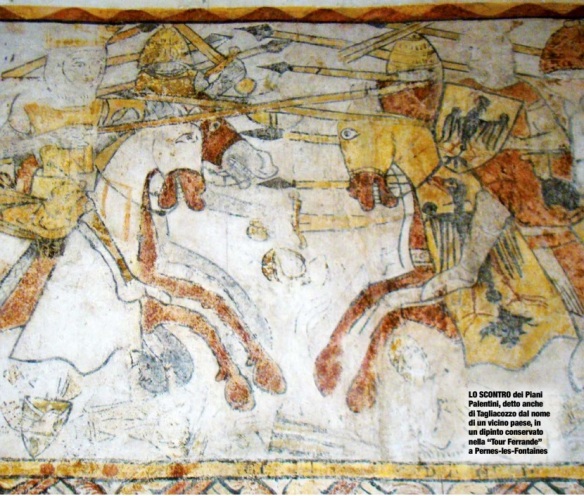TAGLIACOZZO, BATTLE OF, 23 AUGUST 1268
Defeat for Conradin, son of Conrad IV (HRE), the last Hohenstaufen in Sicily. He invaded the kingdom of Sicily with German and Spanish allies in 1267, seeking to make good his claim against Charles of Anjou. Suppporters revolted against Charles in Sicily. The battle was fought in central Italy as Conradin advanced south. Charles took position behind the River Salto. Conradin’s men failed to take the bridge but others crossed further up and attacked the Angevins on the flank. Then the bridge was crossed. Charles recovered by leading a charge with a hidden reserve when many of the enemy, thinking victory theirs, pursued Angevins off the field. He then defeated the returning enemy. It was largely a cavalry battle, a costly victory: `never was victory so bloody, for nearly his whole army had fallen’. Conradin fled but was captured and executed in Naples in October. It ended German Hohenstaufen rule in Sicily, leaving the Angevins in control.
Conradin, the last of the Hohenstaufens, together with Frederick of Baden, was in command of 5-6,000 cavalry, mainly Germans and Italians but also including Castilians as well as Sicilians. He found his road blocked by an opposing force of some 3-5,000 French horse under Charles of Anjou, King of Sicily. The French drew up behind the River Salto in three divisions; two formed into column by a bridge while the third, including Charles himself, was secreted behind a fold in the ground about a mile from the flank. Henry of Cousances, commanding the second column, wore the royal surcoat and bore Charles’s standard in order to trick the enemy in to believing the entire French family was in view. Conradin’s army also drew up in three battles.
The Van, led by Henry of Castile, stormed the bridge, while the second and third, under Calvano Lancia and Conradin respectively, managed to ford the river downstream and then wheeled to attack the flank of the enemy battle. Henry of Cousances was finally slain and the French, badly mauled, broke in flight. The royal standard was seized in the confusion. Conradin held some of his men, but most chased after the French and set about looting their camp. It was now that Charles, having impotently observed the rout of his main force, charged up with his division and scattered the few troops who surrounded Conradin. When the imperial looters saw their commander in flight, they also took to their heels. Henry of Castile managed to rally a number of horsemen and advanced against the Angevins. However, 40 French knights feigned flight to draw out the enemy. As they broke ranks they were attacked by Charles’ battle, while the 40 knights wheeled to strike their flank. Despite a rally, they could not hold off the Angevins, and fled. Conradin, Frederick and Galvano were caught a few weeks later and, like those taken in the battle, were executed. Henry of Castile was imprisoned for 23 years.
CHARLES OF ANJOU, KING OF SICILY (1220-85)
Brother of St Louis. He conquered the Norman kingdom of Sicily and ruled it as Charles I from 1266. In 1246 he married Beatrice heiress to Provence. The papacy offered Sicily to Charles against the descendants of Frederick II. He invaded and was crowned in 1266. He defeated Manfred at Benevento and Conradin at Tagliacozzo. He suppressed revolts in Sicily. He developed Mediterranean interests. He took Corfu in 1267 but failed to recover the Byzantine Empire for the Franks. He was involved in St Louis’ crusade to Tunis in 1270. He was crowned King of Jerusalem in 1278 and became Prince of Achaea. He developed interests in northern Italy, becoming Imperial Vicar in Tuscany and Senator of Rome in 1268. He was defeated by the Genoese in 1273, and in 1275 at Roccavione. His greatest setback followed the Sicilian Vespers in 1282 with the French loss of Sicily. His fleet was defeated off Naples by the Genoese in 1284. He died on 7 January and was succeeded by his son Charles II. His descendants ruled in Naples and Hungary.
CONRADIN, KING OF SICILY (1252–68)
Son of the Holy Roman Emperor Conrad IV who died in 1254 and descendant of Frederick II, He was named Duke of Swabia, King of the Romans, and King of Sicily from 1254 though his position was challenged by his uncle Manfred. He was named as King of Jerusalem but never ruled there. After the invasion of Sicily by Charles of Anjou, Conradin tried to recover his kingdom in 1268. He was defeated at Tagliacozzo, captured and executed on 29 October.
